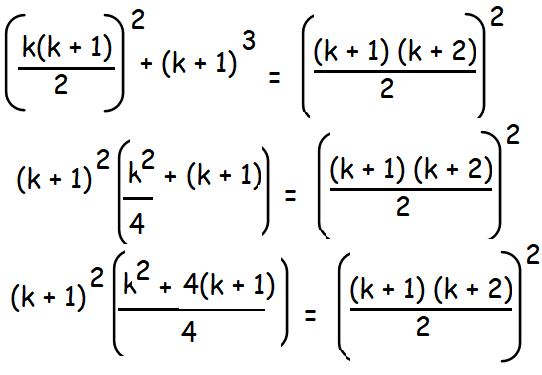MATHEMATICAL INDUCTION PROBLEMS WITH SOLUTIONS
Subscribe to our ▶️ YouTube channel 🔴 for the latest videos, updates, and tips.
The process of induction involves the following steps.
Step 1 :
Verify that the statement is true for n = 1, that is, verify that P(1) is true. This is a kind to climbing the first step of the staircase and is referred to as the initial step.
Step 2 :
Verify that the statement is true for n = k + 1 whenever it is true for n = k, where k is a positive integer. This means that we need to prove that P(k + 1) is true whenever P(k) is true. This is referred to as the inductive step.
Step 3 :
If steps 1 and 2 have been established then the statement P(n) is true for all positive integers n.
Mathematical Induction Problems With Solutions
Question 1 :
By the principle of mathematical induction, prove that, for n ≥ 1
13 + 23 + 33 + · · · + n3 = [n(n + 1)/2]2
Solution :
Let p(n) = 13 + 23 + 33 + · · · + n3 = [n(n + 1)/2]2
Step 1 :
put n = 1
p(1) = 13 + 23 + 33 + · · · + 13 = [1(1 + 1)/2]2
1 = 1
Hence p(1) is true.
Step 2 :
Let us assume that the statement is true for n = k
p(k) = 13 + 23 + 33 + · · · + k3 = [k(k + 1)/2]2 -----(1)
We need to show that P(k + 1) is true. Consider,
Step 3 :
Let us assume that the statement is true for n = k + 1
p(k + 1) = 13 + 23 + 33 + · · · + (k + 1)3 = [(k + 1)(k + 2)/2]2
13 + 23 + 33 + · · ·k3 + (k + 1)3 = [(k + 1)(k + 2)/2]2
By applying (1) in this step, we get

(k + 1)2 (k2 + 4k + 4)/4 = [(k + 1)(k + 2)/2]2
(k + 1)2 (k + 2)2 /4 = [(k + 1)(k + 2)/2]2
By taking square for the entire terms, we get
[(k + 1)(k + 2)/2]2 = [(k + 1)(k + 2)/2]2
Hence, by the principle of mathematical induction, for n≥1
13 + 23 + 33 + · · · + n3 = [n(n + 1)/2]2
Subscribe to our ▶️ YouTube channel 🔴 for the latest videos, updates, and tips.
Kindly mail your feedback to v4formath@gmail.com
We always appreciate your feedback.
About Us | Contact Us | Privacy Policy
©All rights reserved. onlinemath4all.com

Recent Articles
-
10 Hard SAT Math Questions (Part - 38)
Dec 29, 25 04:21 AM
10 Hard SAT Math Questions (Part - 38) -
10 Hard SAT Math Questions (Part - 39)
Dec 28, 25 11:20 PM
10 Hard SAT Math Questions (Part - 39) -
10 Hard SAT Math Questions (Part - 41)
Dec 28, 25 06:05 PM
10 Hard SAT Math Questions (Part - 41)

